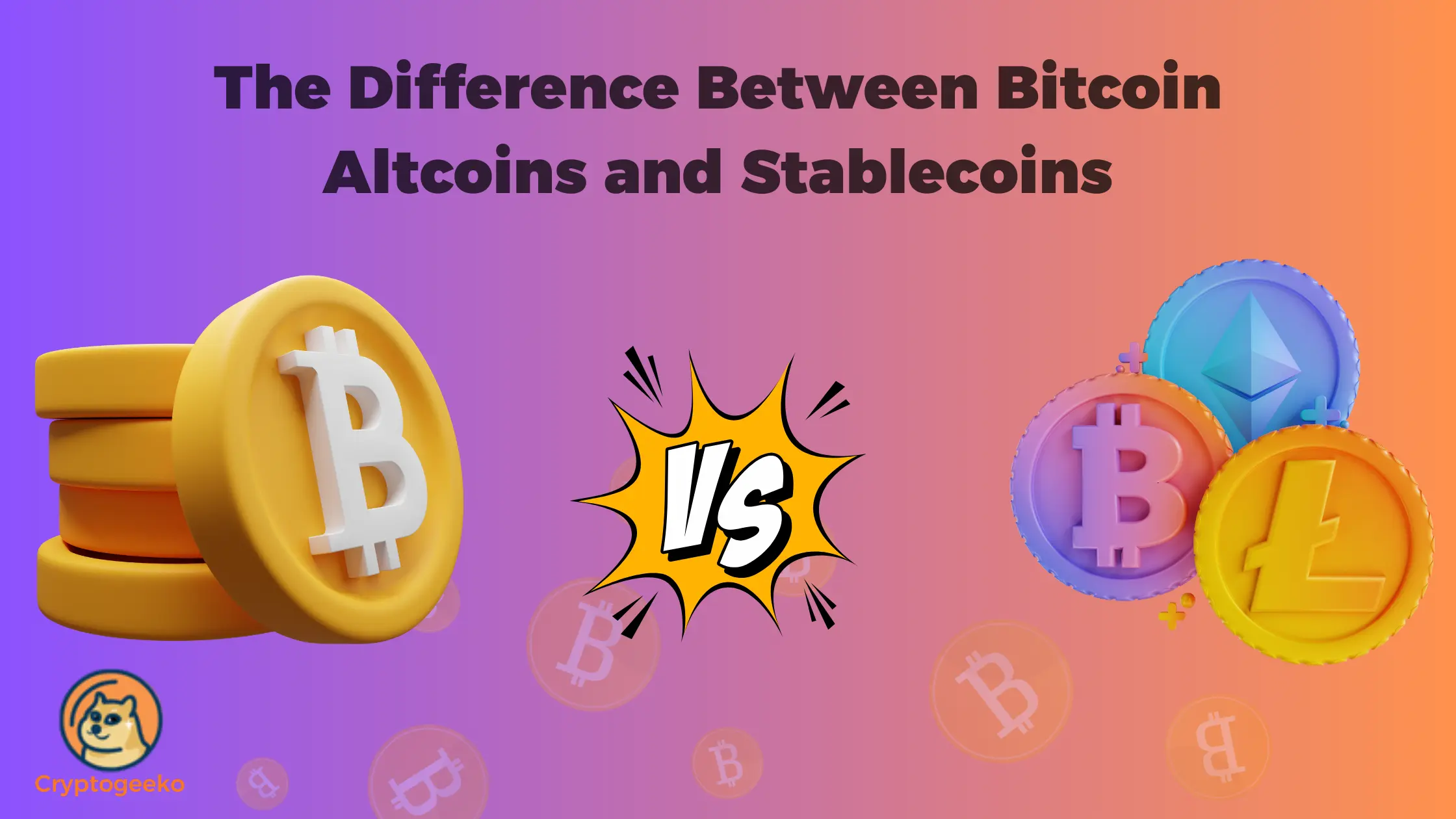The Difference Between Bitcoin, Altcoins, and Stablecoins: Complete Beginner’s Guide

The difference between Bitcoin, Altcoins, and Stablecoins
With cryptocurrencies running rampant, there are so many people hoping to understand how it all works. Bitcoin is a term that, unfortunately, is treated as synonymous with crypto but, really, the list of crypto options goes far beyond that. From altcoins and stablecoins to all kinds of other terms you might be questioning what they really are. With that in mind, let’s understand what the difference is between Bitcoin, what are altcoins, and what are stablecoins. In this beginner-friendly guide, we’ll take you through these concepts introducing them in simple terms and showing how they fit into the larger crypto market.
What is Bitcoin?
Bitcoin is a cryptocurrency, and the first and most well-known in the group is Bitcoin. Created in 2009 by an anonymous person (or group) called Satoshi Nakamoto, it was created on 3 January 2009. The decentralized digital currency, built on the concepts of trust, inability to counterfeit, high liquidity, and diversity of supply, based on a peer-to-peer distributed ledger, designed as Bitcoin, states that it has no central authority that controls it. Bitcoin transactions are secured, instead, through blockchain technology.
How Does Bitcoin Work?
Bitcoin has a peer-to-peer network. That means anyone can send or receive Bitcoin directly from each other — there is no middleman, well neither is there one with the bank. Every time, a transaction takes place every Bitcoin transaction is verified by a network of computers that will make sure it is valid. Once these transactions are grouped into a ‘block’ are then added to a public ledger known as the blockchain.
Because there’s such a limited supply of Bitcoins (only 21 million Bitcoins will ever be mined), they’re often referred to as digital gold. The scarcity of Bitcoin creates its value just like gold or any other rare element does, hence why Bitcoin is considered valued.
Why Is Bitcoin So Popular?
Bitcoin’s popularity comes from several factors:
- First Mover Advantage: Being a new financial instrument it’s hard to earn trust and recognition; Bitcoin is an exception because it is the first cryptocurrency.
- Store of Value: Bitcoin is often thought of as a hedge against inflation, much like gold is considered to be a store of value.
- Decentralization: Unlike government and financial institutions, Bitcoin doesn’t depend on anyone’s control over your finances.
What Are Altcoins?
Now that you’ve figured out what Bitcoin is, you might be thinking, what are altcoins? That is to say, Altcoins are cryptocurrencies other than Bitcoin. Since Bitcoin came into existence thousands of altcoins have been created with different features and use cases. Some of the altcoins strive to learn from Bitcoin’s technology and create an edge over it, whereas there are some altcoins that serve an entirely different purpose.
What’s The Difference Between Altcoins And Bitcoin?
There are many altcoins that aim at something much different than Bitcoin: being a store of value. In the case of Ethereum, one of the two leading cryptocurrencies after Bitcoin, its purpose was to create a basis for smart contracts and decentralized applications (DApps). Contracts are self-executing contracts where everything that needs to be agreed to is written into code. The way people use it is also different for Ethereum, as it is used for payments, but as a store of value rather than for exchanges.
Some other altcoins may concentrate on quicker transaction times, and decrease costs however, they are not only faster than Bitcoin, but they may also boast private ones. Some popular altcoins include:
- Litecoin (LTC): Like Bitcoin’s “gold,” Litecoin is known as “silver.”
- Ripple (XRP): Seeks to simplify the process of cross-border payments for financial institutions.
- Cardano (ADA): A sustainability and scalability-oriented proof of stake blockchain platform.
- Binance Coin (BNB): There are several transactions that can be done with it, such as a token for the Binance exchange, which usually was initialized.

What Are Some Advantages and Disadvantages of Altcoins?
There are some advantages you can get with Altcoins instead of Bitcoin. For example, they may have:
- Lower Transaction Fees: Lower fees are offered by many other altcoins than for Bitcoin.
- Faster Transactions: Some of the altcoins. Process the transactions faster than Bitcoin.
- Diverse Use Cases: There are different altcoins that are for smart contracts, are for privacy, decentralized finance (DeFi), and so on.
However, there are also some downsides:
- Higher Risk: Bitcoin is more volatile than altcoins.
- Less Trust: Bitcoin is the original altcoin, so it has more than a little trust built up compared to newer altcoins.
What Are Stablecoins?
As unique cryptocurrencies, stablecoins are designed to have a stable (pegged) value to something such as the US dollar or gold. Stablecoins were designed to serve as a solution to achieve the benefits of cryptocurrency — fast transactions and decentralization — while avoiding the volatility synonymous with the crypto world.
How Do Stablecoins Work?
Reserves provide a stablecoin with a backstop, meaning that if for whatever reason its value dips below par its reserves will act as a cushion and prevent it from falling further. As such, something like Tether (USDT) is a stablecoin, pegged to the US dollar, so that one USDT will cost approximately one US dollar. As with any standard currency, the stablecoin itself exists on a ledger, but it represents dollars — or, other assets, although they need to be held by the organization behind the stablecoin in reserve to back the value of the coins in circulation.
Stablecoins of other types can be based on algorithms that govern the supply and demand of the coin, keeping the price stable. Stablecoins of this type are called algorithmic stablecoins and are more complicated than they appear.
Why Are Stablecoins Important?
Stablecoins serve several essential functions in the world of cryptocurrency:
- Reducing Volatility: The most important feature of stablecoins is that their value is always stable. With their low volatility, they make attractive traders’ options for those looking to dodge the wild price swings of Bitcoin and its altcoins.
- Bridge Between Fiat and Crypto: Stablecoins fill a bridge between traditional fiat currencies (i.e. US dollar) and cryptocurrencies. Stablecoins are also widely used by many exchanges as the trading pair, which allows much easier trading between fiat and crypto.
- Use in Decentralized Finance (DeFi): We find that stablecoins are heavily deployed in decentralized finance applications, including lending, borrowing, and yield farming. These types of financial activities are made for their stable value.

What Is the Difference Between Bitcoin, Altcoins, and Stablecoins?
What’s the core distinction between Bitcoin, altcoins, and stablecoins, then? Let’s break it down:
- Bitcoin: A store of value, and an inflation hedge. Its supply is of 21 million coins and it works independently from any central authority.
- Altcoins: The term refers to all cryptocurrencies besides Bitcoin. Many altcoins are designed to extend Bitcoin’s technology or provide a different use case such as smart contracts, privacy, or fast transactions.
- Stablecoins: It’s a cryptocurrency that’s supposed to keep a stable value, or price, often tied to a reserve asset, such as the dollar. The reason it is used is to absorb volatility and bridge fiat to cryptocurrency.
What Does it Matter if There’s a Difference?
It is never too soon to know about the major players in the crypto market if you plan on being part of their market. They are Bitcoin, altcoins, and stablecoins. Different forms of cryptocurrency all have different uses, so knowing which to use (and when) will literally help you make better financial decisions.
tain intervals, the amount of Bitcoin you need is just what you need. But if you choose to explore other altcoins such as Ethereum they may be more interesting to you in functionality terms in that case decentralized applications are a thing. Lastly, if you are a trader who needs stability no matter how volatile the market conditions are, stablecoins are the way you go.
Bitcoin or Altcoins? Or, Stablecoins?
Now that you know the difference between Bitcoin, altcoins, and stablecoins, we are going to look at the question of how you pick which to use. Here are a few questions to ask yourself:
What’s Your Investment Goal?
If your end goal is to invest in an area where your money has the potential to grow in value in time to come then surely that has to be Bitcoin. Although it is extremely volatile by nature, it is often the most long-term stable (albeit still short) cryptocurrency. However, if the altcoins that intrigue you have anything to do with particular use cases, like decentralized finance, or smart contracts, then look there.
Are you looking for Stability?
If you are seeking a more stable option then stablecoins can be your answer, especially in volatile markets. While no cryptocurrency ensures you won’t have wild price swings, stablecoins free you from that possibility of having your cryptocurrency prices swing wild — they are tethered to reserve assets.
What’s the Risk You’re Willing to Take?
This market is risky, the world knows. Not a secret! Bitcoin has a longer track record compared to most altcoins, and therefore, most altcoins are much more risky than Bitcoin. Altcoins are more volatile but also with higher potential rewards but it can be tougher to milk the upside. Finally the least risky will follow – stablecoins, but with little price movement.
FAQs about Bitcoin, Altcoins and Stablecoins
- Can I invest in all three types of Cryptocurrencies?
Yes! Crypto investors make part of their portfolio allocating to different types of Bitcoin, altcoins, and stablecoins. It is intended to assist you in bringing a spectrum of view, regarding risk and returns that you desire taking into your investment objectives.
- Are Bitcoin safer than Stablecoins?
Stablecoins are pegged to a ‘stable asset’ (such as the US dollar) making them generally safer from price volatility. To give an example, Bitcoin is a network for long-term storage of value, whereas stable coins are being used (and should be used) in trading, and reducing the risk from unstable market conditions.
- How to Buy Bitcoin, Altcoins and Stablecoins?
Coinbase, Binance, and Kraken, as well as most major exchanges, give you the opportunity to buy all three types of cryptocurrencies. That is all you need to do: open an account, add your local currency, and trade.
- When Is the Right Time to Buy Bitcoin and Other Cryptocurrencies?
Ultimately, you can store Bitcoin, altcoins, and stablecoins all in the same wallet, making it most commonly sold because of the range of cryptocurrencies that you can store with many of the crypto wallets. However, make sure that your wallet supports those coins you back.
- Is it possible that I can Lose Money with Stablecoins?
Like Bitcoin, stablecoins are less volatile, but like Bitcoin, they have some risks as well. If, for instance, the stablecoin organization issuing the stablecoin doesn’t hold tight enough reserves, or screws up the funds responsible, the stablecoin will hurt in value in a way.
Conclusion
Cryptocurrency comprises bitcoin, altcoins, and stablecoins. This will enable you to understand what you need to look out for if you’re ever For example, if you want an investment that has the power to grow at trying to comprehend the purpose of a cryptocurrency, build an investment around it, or even a decentralized application.
- Best Cryptocurrencies to Buy Now: Top Picks for 2025 Investments
- How to Mine Cryptocurrency: A 101 on Bitcoin, Altcoins and what you need to know.
- How to Invest in NFTs (Non-Fungible Tokens)? Beginners Guide 2024
- What is DeFi, Decentralized Finance? A Complete 2024 Guide
- Blockchain Technology Explained: Advantages of Using Blockchain Technology


